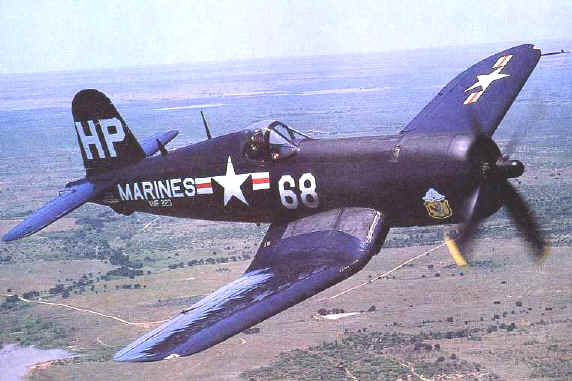 |
|
|||
|
|
||||
 |
|
The Vought Corsair as flown by USMC |
| Designed by Beisel and
Sikorsky, the F4U is regarded by many as one of the greatest combat
aircraft in history, and was in production for a longer period of time
than any US fighter other than the F4 Phantom. As conceived it was
intended to mount the most powerful engine, and biggest propeller, of
any fighter in existence, and the prototype was the first US combat
aircraft to exceed 400mph.
However, early experience suggested that the design was in fact a disastrous failure, especially for carrier operations. The extraordinarily long nose interfered with visibility ahead in a way which particularly caused problems during landing and take-off. The undercarriage had a tendency to break, and the aircraft also had an inclination to bounce alarmingly on landing. As a result the US Navy at first rejected it for shipboard operation. Nonetheless the F4U was adopted by the Marine Corps and quickly demonstrated its effectiveness. Although its low rate-of-turn made it a very limited dogfighter its merits more than compensated for this and its other faults. Its great power, speed and rate of climb, its capacity to roll very rapidly, combined with a powerful armament - and large ammunition supply - and a quite exceptional resistance to battle damage, meant that in early 1943 ( in the Solomons) it quickly demonstrated its great superiority over the enemy fighters. By the end of hostilities in the Pacific War it had established an 11:1 "kill" ratio against Japanese aircraft. At a time when the US Navy still considered it unsuitable for carrier use it was provided to the British Fleet Air Arm under Lend-Lease. The British Navy was desperately short of suitable high-performance fighters and therefore persevered with the Corsair, despite its problems, and the Fleet Air Arm's pilots quickly learned to cope with some of the aircraft's idiosyncrasies. In any event improved versions, which amongst other things corrected the faults in the undercarriage, were later to became available. The US Navy finally adopted the F4U as a shipboard fighter-bomber in November 1944, and by early 1945 large numbers were operating from the fast carriers of the Pacific Fleet - although the longer-established and very capable Grumman F6F Hellcat remained somewhat more numerous aboard the carriers right up to the war's end. However, while the F6F was phased out shortly after World War Two the Corsair continued in service, and new versions were developed. The F4U was used extensively in the Korean War, and production continued until December 1952, by which time 12,571 had been built. |
